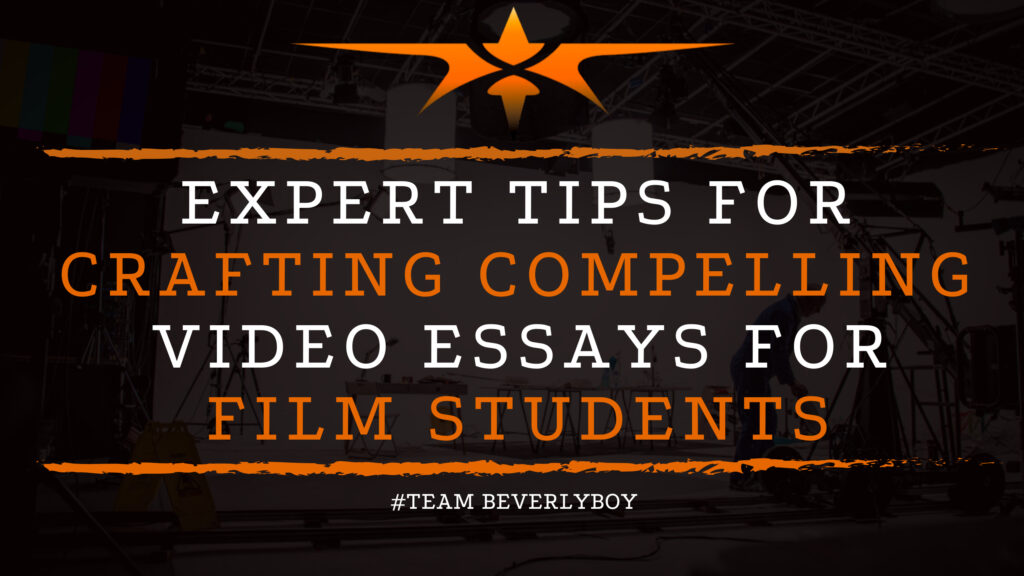Expert Tips for Crafting Compelling Video Essays for Film Students
When I was a film student, and we had to make a video essay, it was daunting because we had to produce a video but also had to edit it. Where a written essay uses words, a video essay adds visuals, sounds, narration, and other elements to create a story or an analysis of a film. Whether you’re grading a director’s style, an entire film genre, or breaking down one particular scene in a movie, making a video essay that is both interesting and organised can present some serious challenges. Here are some tips to help you create an effective video essay. If you ever find yourself struggling with an assignment like this, you might want to consider using a “do a paper for me” service like Do My Paper. It’s a service designed to help students manage their workload by providing expert assistance with academic tasks, ensuring you meet deadlines and maintain quality.

Choose a Clear and Focused Topic
The key to all good video essays is a good topic. Don’t choose something too broad – it can make your video feel unfocused – but instead, look at one specific element of a film, a director, or a theme, and examine it in more detail. Rather than analysing a body of work (the career of a particular director, say), look at something like Quentin Tarantino’s use of non-linear storytelling.
Be Specific with Your Research
Your research becomes so much easier once you have an idea about what you want to write about; then you can drill down into that, and ingest as much information as you can about what you are going to write about. The more you know, the stronger or more interesting your argument or analysis will be. Watch interviews, read articles or other essays on your subject and have a response to them.
Structure Your Essay Like a Narrative
While video essays are more discursive than written text, it’s still important to provide a basic structure for your viewers to follow. Think to yourself: is this essentially a short story with a beginning, middle, and end? If so, you’ve got a strong foundation for a good video essay. The ‘opening’ can be seen as the introduction, a hook where you establish your topic, and provide a reason as to why it’s important. The ‘middle’ or body of your essay is where you break down your analysis into clear bits or sections. The ‘end’ or conclusion can be seen as a way to leave your viewer with a final thought or takeaway. If you struggle with organising your thoughts, many students find it helpful to look into research paper writing companies for guidance in structuring their ideas more effectively.
Use a Script to Stay Organised
A script is also essential to help keep your video essay coherent. Making sure that your points flow logically from one to the next will make your video as engaging for your audience as possible. Writing a script will also help you keep the verbiage and jargon to a minimum, ensuring that your video is accessible to people beyond the confines of your film studies course. Short, simple sentences are key to keeping your language clear and concise, and since you will have visuals to do much of the explaining for you, there will be ample opportunity to let the pictures speak for themselves.
Use Visuals and Sound to Support Your Argument
The focus on images and sound in a video essay is its biggest advantage, and is what truly sets it apart: you can show, not tell. For example, giving examples from the film you’re analysing through clips shows an exploration of the film in progress, not just a presentation of your final conclusion. As you demonstrate a point, you can include the clip from the film where you are talking about. For example, if you are discussing the cinematography in a certain scene, then you can reproduce that scene in your video and point to the details to support your analysis.
Keep Your Visuals Relevant
Every image needs to have some direct argumentative value. You’re not just allowed to cull images from a movie or TV show out of the blue, just to fill space: be sure they’re somehow appropriate to your point. And if you’re arguing about how a film was paced, show a clip that actually exemplifies that pacing. Your visuals shouldn’t detract from your point – they should augment it.
Compare Video Essays to Traditional Essays
Aspect | Traditional Essay | Video Essay |
Medium | Written text | Video, sound, and narration |
Structure | Introduction, body, conclusion | Introduction, analysis, visuals, conclusion |
Tone | Formal or academic | More conversational, sometimes informal |
Argument | Presented through writing | Presented through both narration and visuals |
Engagement | Relies on writing style | Relies on both content and visuals |
Citations | In-text or footnotes | Visual references, on-screen text, voice-over |
Navigating these differences will help you structure your argument differently depending on whether you’re working in written or video essay form. The traditional essay aims for a level of detail that’s hardly possible in visual media: it’s through written text that you can make your argument in the most focused and sustained way. The video essay, by contrast, gives you licence to use a range of multimedia elements to make your point.
Use Voice-Over Effectively
Your voice-over is as important as your footage. It’s where you actually articulate your argument and lead the viewer through your analysis, so your tone should be in concert with the content of your essay. If you’re analysing a heavily dramatic scene, your voice-over should reflect this.
Record Clear Audio
Buy a decent microphone or record your voice-over in a quiet setting; bad audio is the last thing your great video essay needs. Enunciate your words and speak at a reasonable cadence so viewers can follow along.
Editing: Make It Seamless
The last piece of the puzzle is editing. Here is where you take your raw material and try to make a video with visuals, sound and narration that all flow. When your video is playing, you don’t want the viewer to notice cuts because they are out of sync with what’s happening on-screen and in your voice-over. Get an editing software that allows you to cross-fade between scenes, add visual effects, and sync your voice-over with your visuals.
Pay Attention to Pacing
Another mistake is a lack of pace. I see film students regularly either hurrying through a bit of analysis because the scene’s moved on, or else paying too much attention to one part of the argument or description at the expense of the whole. Your tempo’s got to suit the mood and momentum of the piece of writing you’re producing. Don’t let things stand still – don’t let the essay stop for breath if the thing you’re describing is moving along briskly. On the other hand, it’s important to give space to a shot or a scene when you want your reader to appreciate a piece of filmmaking.
Conclude with Impact
Like a written essay, the conclusion is also critical in the video essay. Summarise your main points without just reiterating them, and leave the viewer with something to take away. Perhaps a final observation about the film, a question to think about or a call to action.
Final Thoughts
Writing an effective video essay requires good writing, careful thinking and a bit of creativity with sound and images. If you zoom in on an area of interest, organise your ideas well and use your visuals and sound to support the argument, you should end up with an interesting piece that people will enjoy and learn from. And the more you write in this way, the more you’ll find your own voice and style, and that’s when your work will emerge from the crowd.


